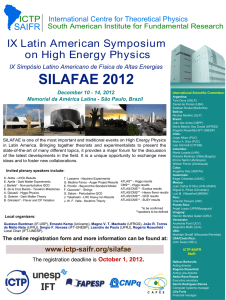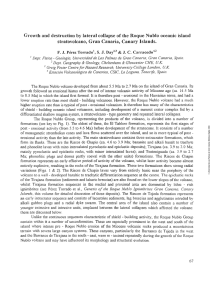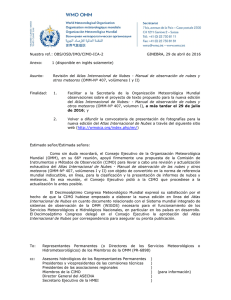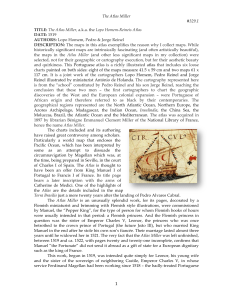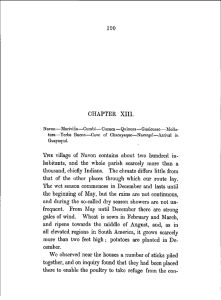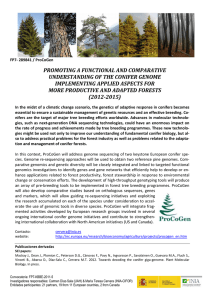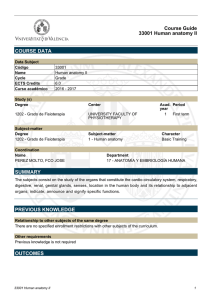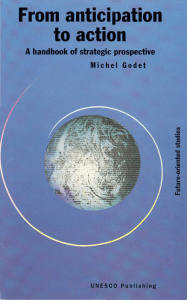Full article
Anuncio
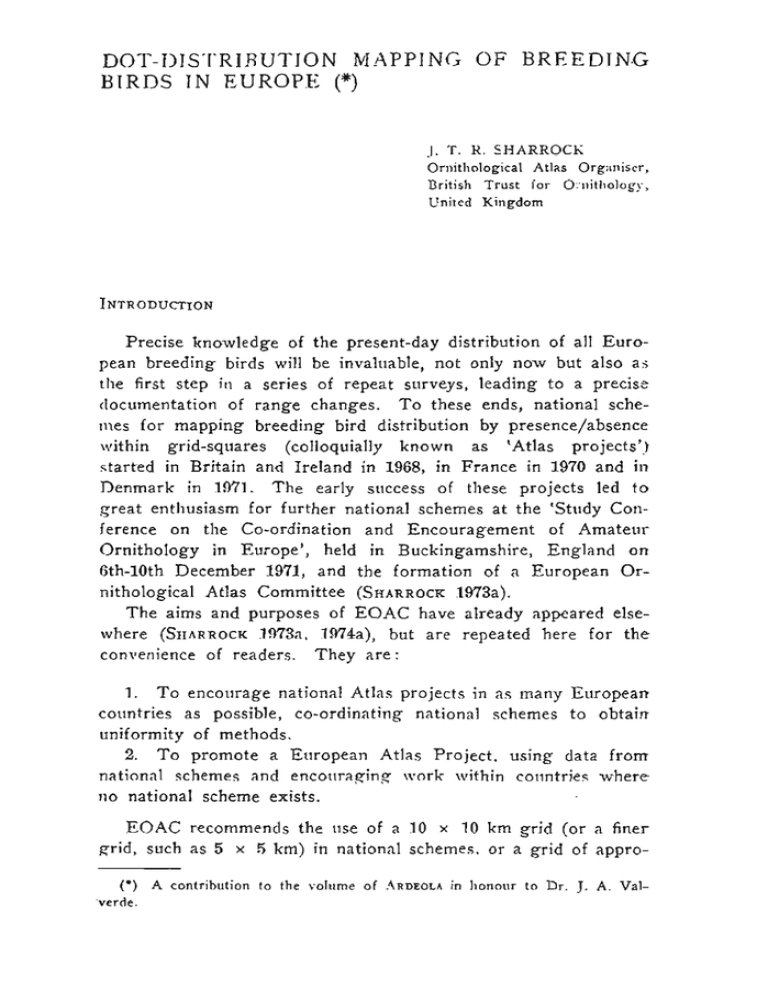
DOT-J~lS'fRJRUTJON MAPPJNG OF BREEDJNG BIRDS J N EUROPE (*) R. EHARROCK Oriiithological Atlas 0rg;iniser. British Trust lor O:iiitliolug.v, L'nited Kingdom J. T. Precise knowledge of the present-day distribution of al1 European breeding birds will be invaluable, not only now but also as tlie first step iii a series of repeat surveys, leading to a precisr documentation of range changes. To these ends, national schemes for mapping breeding bird distribution by presence/absence within grid-squares (colloquially known as 'Atlas projects'k started in Britain and Ireland in 1968, in France in 1970 and in Denmark in 1971. The early success of these projects led t o great entliusiasm for further national schemes at the 'Study Conference on the Co-ordination and Encouragement of Amateur Ornithology in Europe', held in Buckingamshire, England on 6th-10th December 1971, and the formation of a European Ornithological Atlas Committee (SHARROCK 1973a). The aims and purposes of EOAC have already appeared else1IYI3a. 11)74a), but are repeated here for the where (SHARROCK consenience of readers. They are: 1. T o encourage national Atlas projects in as many European coiintries as possible, co-ordinating national schemes to obtain uniformity of methods. 2. To promote a Etiropean Atlas Project. using data from national schemes and encoitraxing work within coitntries where no national scheme exists. EOAC recommends the use of a 10 x 10 km grid (or a finer ~ r i d such , as 5 x 5 km) in national schemes. or a grid of appro(-1 A contrihution to the vollime of verde. ARDEOLA in honoiir to Dr. J. A. Val- 798 ARDEOLA, VOL. (m (ESPECIAL) ximately these dimensions, depeiiding upon map-availability. EOAC is willing to advise countries starting a new scheme on t1.e most siiital>le grid. Tlie European Atlas (in which the resiilts from natioiial schemes are combined) use 50 x 60 km sqitares as its mappiiig iuiit, and it is planned to start tliis project in 19%. The categories of breeding evidence agreed by al1 delegates tc EOAC are shown in Appendix 1. These are divided into four grades, the top three of which (B, C and D) are colloquially referred to as 'possible breeding', 'probable breeding' and 'confirmed breeding', and these are plotted on al1 maps as small, medium and large dots. Once a species has had breeding confirmed (Grade D) within any recording unit, that species may be disregarded within that unit. The aim, therefore, is simply to obtain the highest possible grade of evidence for eacli species within each recording unit. EOAC consists oí one delepate from each country undertaking o r planning an Atlas project. There are at present 17 delegates, rrpresenting Relgium, Britain, Bulgaria, Czechoslovakia, Deni i i r Finlaiid, France, Germany (FDR), Ireland, Italy, Netherlandr. Poland, Spain, Sweden, Switzerlaiid, Turkey and Yugoslavia. It is hoped that every Eriropean country will soon have a delegate oii EOAC. Every country which has reported progress to EOAC has found that the response of ordinary bird-watchers to Atlas fieldwork has Iwen such that results have always greatly exceeded initial expectntions. T o tliose who have not yet any experience of Atlas projects, it should be stressed that it provides enjoyment and satisfaction to the field-wurkers, taking them into areas and Ilabitats seldom visited by bird-watchers in other circumstances. Come of the methods and techniques of Atlas fieldwork have been outlined, for example, by SAARROCK (1974b, and other references in that paper) and the background and initial problems by KLIMK I E W I C ~ and ROBBINS(1974), RANDIK(1974), SCHIFFERLI(1974) :ind YEATNAN (1974). New projects can now take advantage of Fig. 2.-Ureedilig di~lributioiio1 Red-hnclicd Slirilie Lmniw rollurio itr Europc, ns shoivii by Atlas licldwork. Compariroil sliould Ibc in:idc witli tlic corcr:ige slioivli in Fig. l. Tlie al>sciice o1 records lroni Ireland, most o1 iiorilicrni i3riidii and most o1 iiortliern Fr.~iice and ivesterii Udpium riilcets gcnitiiic rliriributioi~ pattcriis, m d a recen1 range eontr;ictiovi iii Brilaiii aiid tlie adjaccnt pnrtr o1 tlie Continciit; outsi<le iltese nrcar, nhrence usiially rellects lack 01 coveragc at ~ m s c n t . No record ir e;irlier tliün IWX, I>ut Tiible 1 sliould IK consultcd t o <letermine tlie yearr o1 ii:ition;il survcys. (Tlie Polisli d ~ t a are derired lroiii n pilot sludy iii 1974.) tlie experieiice gained aiid lenrii from tlie iiiistakes made by tlie coiintries >~liiclillave drearly stiirtcd :\tliis projects. The metliods are simple :iiid straiglitforward, easily carried oot 1).' :iinateiir I>ir<l-w;itchers. As two simple es;iiiiples: it Iias 11ec;i loiiiid tliiit :iii ol>server \ h o is esp~riciicediii Xtliis lieldwork cnii liiid of tlie species breediiig iii ;i 1od;iiid 10 x 10 km sqiiare iii jiirt on:. kiy o[ field\\-ork: siid tli:it proof of l>ree<liiigis iniicli casier to olitaiii late iii tlie Iircediiig sciisoii, \~ltciireceiitly-fledged yoiing I>irds c;iii Iie ol)served. tli;iii ezirly iii tlie Iireediiig seasoii (e. g. iii Brit;iin aiid lreliiiid. 35 O/, o l tlie rpecic:: scei: iii n ckiy iii April Iriit í i ;/, of tlie sprcirr secfi iii ;i &iy iii Jiily) (Siini<it~cl< l!)íl, l!lí:<l>). 'ile rewlts ol)taiiierl in ~i;ition:il scliciiie': are ii1re:idy providiii~ iicw ;iiid prccise iiiformatioii oii Iiirrl distrilnitioiis \diicli forrn a i ~ esseiiti;il 11:ickgroiind lor ciirretit stiidies of iiitlividital species :iiid :i ¡)ase-linc lor fiitiire work oii tlie factors itifliieiicing r:iiigi. I i n g s . 'l'he estent o l cn\.cr;igc of I*:iirope 11.v ii:itioiinl scliriiic.; is slio\vii iii Kg. 1 ;iiitl tlie stntc o l .Atlas piojccts i i i Eiirope. :i? rrported to EOAC, i': slioivii iii T;iI11c l. Tlie loregoing I>ackgroiind iiiforiii:itioii 1 iiot ¡>e iicw to rr:irlers iii tliose coiiiitrirs :ilirady rrprci;eritecl oii EOAC. Tlic aim of tliis p:iper, Iio\wvcr. is to sliow. lor tlic first time, soinc of tlie resiilts of E0.K co-opcrntioii. All meiiiBer coiintries witli Atlas scliemes iii operation liaie siippliecl ht:i froni tlieir imtioii:iI scliemes. and a comhiiied inap for Red-l>:icked Slirike 1.oriifts rolltcrio Iias heeii compiled. iisiiig tlie ;igrrrd x G0 lmi Eiiropeati grid (Fig. 1). Tliis iii;ip. iiicoriiplete as it clearly is. $ves a foretnste of wliat tniiy I>e acliieved alter 19%. wlieii it is Iioped to iiiitiate co-ordiii:ited scliemes (iicw or repeat Atlas projrcts) iii evrry European cooiitry. Those coiiiitries mliicli will linve coinpleted a national Atlas scliemc prior to l!lS.i will clcnrly llave two advantages: aii earlier set of ~listril~iitiotimaps ivitli wliich to compare tliosr o l 19% on\rardr; and. perliap eveii more important. eñperiericr of carryiiig oiit aii Atlas project and n hand of cxperienced o l w r r e r s eager to start afresh. 8m ARQEOLA, VOL. ?i (FS.JP~CIAI.) (175) T o sliow n~appingo11 the fiiier grids of tlie national projects, member coitntries sttpplied eminples of species otller tl~aiiRedhacked Shrike. A selection of tliese is sliown in Figs. 3-8. Dotc:istribution mapping on a suital~lyfine griti gives a clear pictiire of a species' national distribution, C u n 1r Y (Pals) Yenr o1 stwting (Asa de partida) ........ 1973 ......... 106R ....... ? . 1973 .... 1971 .. ... 1974 .... ..... 1970 . 1975 ..... .. 1968 ........... ? ... 1972 ....... 1975 ..... .... 1979 ........ 1974 . . 1972 ......... 1978 . .. 1979 (pihll) Rtlqium Britnin Bulgaria Czechoslovakia Denmsrk.. . Finland.. . France Germany (FDR). Ireland Ilily . Netherlands Poland.. Spain Sureden Swilzcrland.. . Turkey Yugoslavia . . Year o t complption (Año de finalizaci6n) 1972 1374 1974 - 197'' - - Grid (Re l icu l o) 10x 8 km rcctangles 10xlOkm squares lOxlOkm squares 10x10 km squaies 3 x 5 km squsres 10x10 km squares 20x27 km rectangles 50x60 km squares 10x 10 km squares ? 5x 5km squsres 50x50 km squares 28~12h ~a5diilln 5x 5 km sauares 10x10 km squares 10x10 km squares l 0 x 10km squares EOAC Delrgats (Delegado en el EOAC) Dr. P. Devillers Dr. J. T. R. Sharrock Dr. St. Dontschev Dr. E. Staslny T Dybbro Dr. L. Sammalisto L. \'calman DI G. Rhsinwald D. Scott Dr. S. Frugis Drs. R. M. V. Teixeira Dr. 2. Bogucki Dr. F. Purroy Dr. S. Svensson Dr. A. Schifferli o10 EOAC Convenors 1. Geistcr Fig. 3.-Breediug distribution of Fieldlare T u r d w pilarir i i Dclgium during (Tlic recording units are 10 x 8 km rectar~gler.) Tliis species i6 rapidly colonising from the east. 1-74. (Uirtriburióa de la poblaiión de Turdus pilaris que nirida ei! UPlgira, oiíos I!nfwtidod de ruodrÍoda san apui 10 x 8 km. E l Zorsal Real ca1or:iza ráFi- 74. La daiix>ite procedente del Este.) T:ig. 4.-Brrrrlinl: dislril~iitioii o( Dipper C i k h r ririclttr in Briuin and Ireland duniig 1Wd-72. (Th rwording units are 10 x 10 kms squares.) The d:slriliiition Iñrccly mirrors that of high ground an fnst-lloiving strcniis nnd rircrs. I W C.-Leeding distribution o1 1.ong-tailed Tit Aegithlos cauhtur in Denmark during 11)11-74. (The recording units are 6 x 6 km squares.) (:Irea de nidificaci6n de Aegithatos caudatur en D h m r r a , affor 1911-74. Apui la unidod d~ cuadrícub Son S x 5 Km.) Fig. 'l.-Breeding distribution of Fñn-lailed Warhler Cislirolo juwidis in Prailcc duriiig 197074. (The recording units are 20 x 27 km rertnngles.) This shows the rtriking recent spread northwards oii tlie Atlnntie caast. . APDLOU, VOL. 21 ., (ESPECIAL) . .. .. (19%) Fig. 8.-Breeding distrihution o l Citril Finch Scrhus r i t h e t t a iii Switzcrlai>d diiiing 197274. (Tile recorditig units are 10 x 10 km squares.) The distribution mirrors that OS the rnountaiiis o l the Alps and Jura. IAren de ttidiliruri& del Verderón Serruno (Serinus citrinella). en SUUD. Cu unidad d r ruudricula son 10 x 10 Km.] nGor 1.W-74. .Aquí Enquiries about the Atlas projects in countries which have a delegate on EOAC should be directed to the relevant national delegate (see Table 1). Enquiries regarding countries not yet represented on EOAC should be directed (in English, please) to one of EOAC's two Joint Convenors: T. Dybbro, Zoological Museum, 2100 Copenhagen, Denmark or Dr. J. T. R. Sharrock, 59 Curlew Crescent, Bedford MKl1 7HY, England. The work of EOAC depends entirely on tlie co-operation of the member countries, and 1 am most grateful to al1 of the delegates to EOAC who supplied results of their national Atlas projects for use in this paper. The selection of six examples of national species maps was not easy, and 1 apologise to those delegates who supplied maps which have not been included. I gratefully acknowledge the help of Dr. G. Bergman, Dr. 2. Bo. gucki, Dr. P. Devillers, T. Dybbro, 1. Geister, H. N. Leys. R. F. Porter, Dr. G. Rheinwald, Dr. L. Sammalisto, Dr. A. Schifferli, D. Scott, Dr. K. Stastny, Dr. S. Svensson, Dr. J. Wattel, and L. Yeatman. 1 also wish to thank the European Invertebrate Survey secretariat for permission to use tlie bnce-map of 60 x 50 km squares in Figs. 1 and 2. (Grados y talegorías sobre polmrialcs aves i>rdigenas, Mra uso de lodos lo: proyectos de Allos europeos) Grade Category --- A O B 1 2 sprcics observed in the breeding season. species observed in the Ireedine season and in posoiblc nesting habitat. singing male(s) precetit (or hrceding callr heard) in tlic breeding oeason. ARnEOLA, BM) Gradr Catcgory C 3 -- 4 5 6 í X H D 10 11 12 13 14 :1 16 VOL. (~SefXlAl)((lei5) s pair obsersed in suitab'e nerting habitat in the brceding. season. n permanent territory presumed through the registration of territorial heliaiiour (song, ctc.) on at least two. dilfcrent days at leiist a aeek apart at the same place.. courtship and display. visitinr probable nest-sitc. naitale'l behnviour or anxiety calls lrum adulls suggesting: n e a or young nearby. hrood y~tchesun adult examined in tlie hand. nest-building or cxcavating of nest-hole. distmction-displny or injtiry-feigning. used nest or egg-shells found (wcupied or laid within the p r i o d of the surve).). recently-fledged youiig (nidicolous species) or downy youug (nidifugons species). adults entering or leaving nest-site in circumstancea indicating occupied nest (including high nests or nestIioles, tlie contents of which cannot be seen) or adult seen incuhating. adult cartying faecal-sac or Iood for younE. nest containing eggs. nest with young seen or heard. EOAC r e c o m n i e n d s that eacli n a t i o n a l sclieme should use i t s o w n 'letter code for the 1'7 categories (O f o r AO, single letters for c a t e g o r i e s in grades B and C, a n d double letters f o r categories i n grade D), rather t h a n the numbers O to 16, which merely indicate the agreed o r d e r o f increasingly good evidence. The l e t t e r ~ s h o u l d p r e f e r a b l y he the initial l e t t e r s o f key words, such as C f o r 'chantetir' or NY f o r 'nest and young'. so that they are easily remembered by the field-workers. . The history, aims and progwsr of the l k o p e a n Ornithological Atlas Committee (EOAC) are suniinarisrd. The lirst erer provisional map 6f a spccies' breeding distribution in Europe derivcd from Atlas lieldwork ir shown (Wed-backed ShrPe L a x i ~ s rollurio). as are sewral examples of mapr from. national Atlas projeils oii liner prids. MBodo ,Wutitol @>aro rortngru.hr qttc 10 distribución de lar rrrsries de a ? m anidou rtt Ewropo Se exponen ;iqui, nwy rcíuinidamente, la historia, objetivos y logros 1i;lsta aliorñ conseguidos por el Comité del Atlas Ornitol6gico Europeo (EOAC). III continente se divide conlorme a una euadricula de 50 x 50 kil6metros. l . a 1 n la distrilruciiiri de prospeccloncs rtaliradas durante los años IWIB74. La primera rwin de <listriinicián obtenida, aiin provisional, se refiere al Alraudán Dorsirrojo. y se exhibe en la figura 2. Se entiende que basta un solo dato seguro de reproducción de cadii especie dentro de una determinad* cuadricula. par:, que conste un punto (círculo) negro en ella. El trabajo cnrtográlico $e realiza con independencia dentro de cada pais bajo la direcci6n <le un rolo ~lirecioro coordinador nacional. Cada pais utiliza su propio retículo, que pue<k ser igual o menor que el general, como puede verse cn In hhla 1. Ia cdapciún de retículo se suele ajustar al del mapa gcozrálico oficial, el cual varia de unos paises a otros. Para calilicar a un ave con rrlerenei;i a cada cuadrícula, se dispotie d.. unr base de informacibn muy rarinhle segiin especies y circunstancias. N o es un problema sencillo si el are es rara. o escnsñ, o cuando se reliere a zonas apenas exploradas q«e no pueden prmpeetirse con la debida dedicación o que soto s í visitaron en épocas poco adecuadas. Por ello. conviene precisar cuidadosamente la clase de información disponible, segitn se propone en la escal.! de grados y c.itegorias d d ApCndice 1. Las figuras 3 a 8. sirven para ilustrar resultados ohtcnidos por diversas orgnnizariones nacion.ales rou relacii>ii a las e~peciesde aves que en cada caso sc indica. K~Yai~tEwrcr. M. K., and Ronsisr. C. S. (1974): Tlie breeding hird Atlas of Uontgomery County, Maryland, U. S. A. Aelo Or"ifholog¿co, 14: 441 r158. R m m , A. K. (1974): Report on bird Atlas work in Czechoslovakia. Aria Omithologiro, 14: 43.940. z%lo ARDEOU, VOL. 21 (ESPEZAL.) (lm) ScnwseaLi, A (1974): The Atlas project in Swilrerland. Acta Or~tilkologica, 14: 4424U. S ~ A R R O C K , J. T. R. ( M i ) : Seasonal changes in ease of proving breeding. Rird Study, 18: 88. (1013a). Ornitbulogical Atlasts. Auspirium, ,Q (suppl.). 13-19. (l013b): Kace o( specie~segistration in Atlas work. Rird Study, 2U: 88ml - (1014a): Uinuicr o[ the second meeting oi the European Orn'tho!ogicd Atlas Cotnmittee. Actn Ornitholagica. 14: 404-4ii. (1974b): The ornitliological Atlas project in Rritain nnd Ireland. Methods rnd preliminary results. Actn Ornithologtca. 14: 412428. Y~ATKAN, L. (1974): Tlie French Atlas: ways and means. Ario Ornithologira, --- -- 14: W4.B.
